|
The bridle path,
Dresden
a short trip off the beaten
path
  
click the
"contents" button to get back to the main index & map
previous:
Moneto House, Ricardo Street,
Dresden
next:
Pall Mall, Hanley
|
Historian Fred Hughes
writes....
Longton Freehold Land Society bought Spratslade Farm, half a mile or so
south of Longton for £5,000. In the 1870’s they profited by selling plots
of land and by financing the building of houses. When it was finished they
called it Dresden. Historian Steve Birks reminds me that this impressive
Victorian venture was encouraged by Liberal politicians who were eager for
the votes of the new householders.
|
“The connections are recorded in the names of the streets, most of
which are the original.” says Steve.
“Dresden streets were named after prominent national Liberals like
Richard Cobden MP, founder of the Anti-Corn-Law League; Charles Pelham
Villiers and Lord John Russell. There were also some local Liberals like
Stafford MP John Wise, and John Lewis Ricardo, MP for Stoke. All these
are remembered in street names including the tenth Earl Carlisle, a
Liberal Unionist MP for Birmingham who had financial connections with
the Rev James Taylor, the founder of the Freehold Land Societies. The
one political exception to have a street named after him is Robert Peel,
the Tory Prime Minister who instituted Free Trade policy resulting in
the abolition of export duties – the so-called Corn Laws.” |
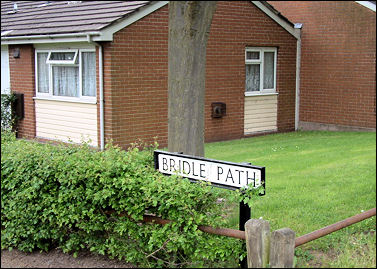
When the Longton society bought Spratslade Farm it had to
accommodate an ancient bridle path leading from Longton to Trentham. The
streets were designed in geometric blocks and the bridle path was included
as a pedestrian way between the old Belgrave Road and the new Ricardo
Street. Few changes have been made where some terraces have been replaced
by council houses. But the lane, part of which is now named Bridle Path,
remains largely untouched. Lillian Pullin, age 73 lives here.
“I came to Dresden forty-years ago,” she recalls. “We had a house in
Russell Street and then a bungalow on Bridle Path about two years ago.
They split Villiers Street in two with one half being renamed Beadnell
Street back in 1970. A lot of old shops went as well. One we called the
Tonks, but I don’t know why. Same with another called the Tin Shop.
Different times and different values I suppose.”

Today’s bridle path seems relatively peaceful and undisturbed. But further
along a couple of elderly residents grumble about noise at night when
youths gather to behave irresponsibly. Spray-can graffiti provides
evidence of tribal gatherings, though the crude daubs and ridiculous
nom-de-plumes of these nocturnal expressionists confirm they are not
bona-fide artists.
“The trouble is,” one pensioner tells me, “Nobody seems bothered these
days. I’m fed-up of ringing the council and you never see the police down
here.”
Dresden’s bridle path indeed isn’t used so much
these days by pedestrians, which is possibly why the gangs collect in
quiet isolated pockets. Originally bridle paths were busy places. Their
routes were difficult to negotiate by wheeled traffic and so packhorses
were led by their harnessing tackle, particularly along the precipitous
inclines of Dresden.
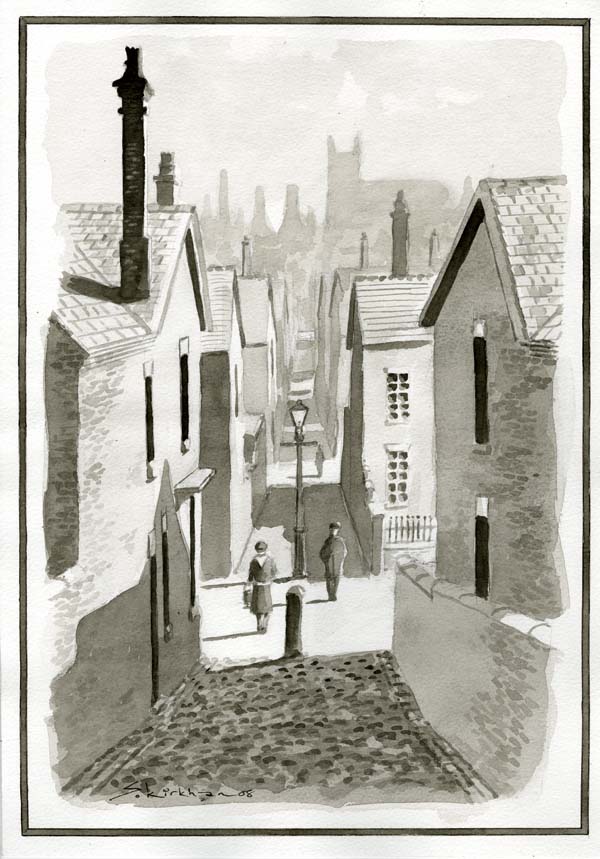
Dresden - the backs - the bridle path
Sid Kirkham
|
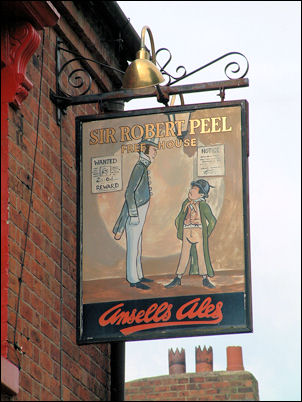
a beautifully hand-painted swinging-sign records its transfer to Ansells
in the 1970’s
The vertical narrow bridle path climbing from Belgrave Road to Ricardo
Street interrupts a number of streets on the way. Alongside one of these
crossings in Peel Street, the splendidly-named Sir Robert Peel public
house sits in modest dignity. Few pubs in North Staffordshire carry so
much visible history as this old Victorian beer-house. Acid-etched
original windows tell you it was first owned by Parkers Brewery. Then a
beautifully hand-painted swinging-sign records its transfer to Ansells in
the 1970’s, while high above the door the familiar scroll of Bass hints at
another attempt at permanency. The red-painted entrance door is like any
old terraced house – but it is original. Can you imagine grandfathers bent
over hands of cribbage in gas-lit corners telling tales of times past? And
that’s how it nearly is today, except karaoke has replaced the weekend
piano sing-along. Catherine Whitehurst and Linda Green are the current
tenants.
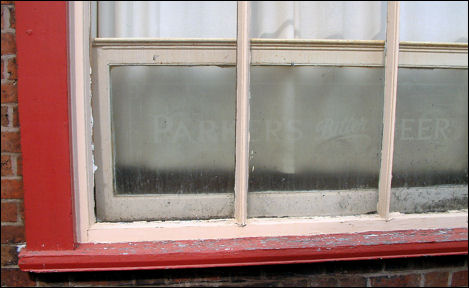
Acid-etched original windows tell you it was first owned by Parkers
Brewery
“I’ve lived in Dresden for 23 years,” says Catherine. “We manage the pub
for the owner and basically cater for the local trade. But unfortunately
business, in common with the public-house industry generally, has
declined quite a bit. We don’t open during the day until five-ish; this
suits the locals and people coming from work. I have to say our business
does rely on karaoke which is very popular. So we build events around
this at weekends and a couple of nights in the week.”
Pub regular is Dresden resident Albert Brian, age 67.
“There used to be pubs all over this part of Longton,” he claims. “There’s
still is a lot around here but more than enough have been demolished. The
Dunrobin, the Sailor Boy and the Lord John Russell have all gone. I
suppose they served their time. Nothing lasts forever. But they still pull
the best pint in Longton in Sir Robert Peel.”
I suppose a dedicated customer would say that. Nevertheless 32 year-old
self-employed plumber Gary Harris agrees. He goes out of his way to call
every night.
“I like to use a pub that is quiet and traditional so I can wind-down
and gather my thoughts after a hard day. A couple of pints and I’m off
home,” he says.
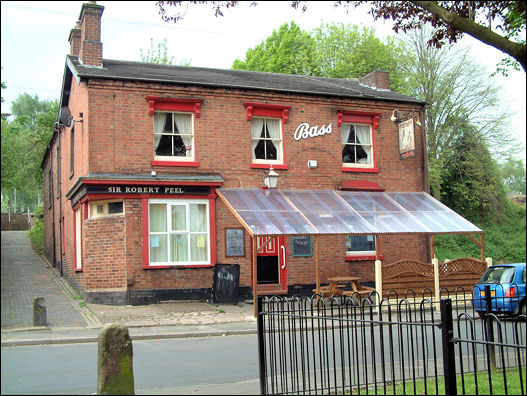
high above the door the familiar scroll of Bass hints at another attempt
at permanency
The best thing about Sir Robert Peel is the formality the management and
customers assume when speaking its name. Not for them some soft
abbreviations like Bob’s or Bobbies. Nicknames like Peeler’s or Corner-Pin
are never used in reference to this old pub; no suggestion of say ‘Cath’s
Place’. No! It’s Sir Robert Peel, all or nothing. And nothing resonates
with Victorian social improvement more than a pub’s name. Here it stirs
the ghosts of the political reformers that still seem to haunt Dresden’s
streets and alleys.
|
“Discovering old path awakens a realisation of social history,”
concurs Steve. “Dresden’s bridle path was here before the houses. It cut
through Spratslade Farm and Sutherland’s estates to Trentham and Stafford.
It was a link with other trading towns and it’s wonderful to see how well
it has survived.”
 More on the Bridle
Path in Dresden
More on the Bridle
Path in Dresden
 Dresden and the
Longton Freehold Land Society
Dresden and the
Longton Freehold Land Society
|
![]()
![]()
![]()